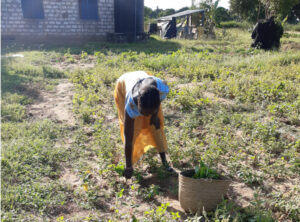Model Farm NICHE-KEN-212 Water management and livestock project Pwani University
 By Kenneth Kipkoros, Intern at the School of Agricultural Sciences and Agribusiness Pwani University, evaluating daily the model farm
By Kenneth Kipkoros, Intern at the School of Agricultural Sciences and Agribusiness Pwani University, evaluating daily the model farm
The model farm consists of one hectare. It concerns an integrated farm with livestock namely dairy and chicken together with food crops. Recently maize and cassava have been planted, together with watermelon, brinjals, tomatoes, capsicum and herbs.
BASICS MODEL FARM

Model Farmer harvesting amaranthus that endured the dry season.
The model farmer uses spacing when planting crops, and recommended seed rates. Intercropping is being practiced, namely maize with cowpeas and eggplant with amaranthus. Crop rotation takes place each season. Considering plant families and type, a plot where cereals were harvested, will then be planted with a crop such as cowpeas. This will increase soil fertility and controls pests and diseases. The integration of agroforestry at the model farm (pine trees and shrubs) enables the farmer to access timber for repairs and helps control runoff and soil erosion. The farm uses farmyard manure to reduce fertiliser costs.
MODEL FARM ENTERPRISE
One hectare is manageable and enough to maintain a household with more than seven members for a longer period of time. Some crops take a long time to mature due to the salinity of the soil at the model farm. Enterprises like layer production collapsed due to high cost of feed and diseases such as Newcastle disease.
WATER ACCESS
The model farm has access to water through the borehole and storage tanks, this is instrumental. This water is used for irrigation, household consumption and dairy production. The availability of water has led to higher productivity in both dairy and farming. Irrigation of watermelon and tomatoes in nursery has been established. Water meters are installed to economise on the use of water at the model farm.
SOCIO-ECONOMIC INSIGHTS
The model farm is the source of food and income for the model farm family. They have two students in high school and three in primary school and school fees are paid through the model farm. Dairy production is the most productive enterprise, followed by olericulture. Broiler production has increased the income of the model farming family.
LABOUR FORCE
Use of machines such as a backpack brush in the model farm has made work easier, such as trimming of fences, harrowing land and cutting grass.
OUTREACH
The model farm acts as a learning centre for many people, including students who perform practicals and farmers who want to learn more. The model farm produces seedlings for other farmers in the community. Benchmarking exercise is currently underway to establish farmer to farmer expansion.








